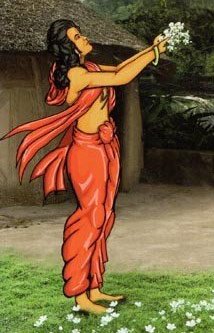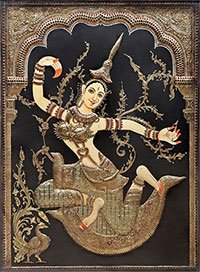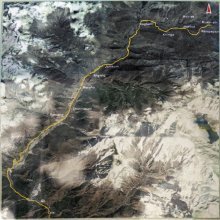Upatyaka, Upatyakā: 14 definitions
Introduction:
Upatyaka means something in Hinduism, Sanskrit, Hindi. If you want to know the exact meaning, history, etymology or English translation of this term then check out the descriptions on this page. Add your comment or reference to a book if you want to contribute to this summary article.
Images (photo gallery)
In Hinduism
Purana and Itihasa (epic history)
Source: archive.org: Puranic EncyclopediaUpatyakā (उपत्यका).—A country in Bhārata. (Mahābhārata, Bhīṣma Parva, Chapter 2, Stanza 55).
Source: JatLand: List of Mahabharata people and placesUpatyaka (उपत्यक) is a name mentioned in the Mahābhārata (cf. VI.10.54) and represents one of the many proper names used for people and places. Note: The Mahābhārata (mentioning Upatyaka) is a Sanskrit epic poem consisting of 100,000 ślokas (metrical verses) and is over 2000 years old.

The Purana (पुराण, purāṇas) refers to Sanskrit literature preserving ancient India’s vast cultural history, including historical legends, religious ceremonies, various arts and sciences. The eighteen mahapuranas total over 400,000 shlokas (metrical couplets) and date to at least several centuries BCE.
Kavya (poetry)
Source: OpenEdition books: Vividhatīrthakalpaḥ (Kāvya)Upatyaka (उपत्यक) in Sanskrit (or Uvaccaya in Prakrit) refers to the “foot (of a mountain)”, as is mentioned in the Vividhatīrthakalpa by Jinaprabhasūri (13th century A.D.): an ancient text devoted to various Jaina holy places (tīrthas).

Kavya (काव्य, kavya) refers to Sanskrit poetry, a popular ancient Indian tradition of literature. There have been many Sanskrit poets over the ages, hailing from ancient India and beyond. This topic includes mahakavya, or ‘epic poetry’ and natya, or ‘dramatic poetry’.
Sports, Arts and Entertainment (wordly enjoyments)
Source: archive.org: Syainika Sastra of Rudradeva with English Translation (art)Upatyakā (उपत्यका) refers to a “valley” (suitable for hawking), according to the Śyainika-śāstra: a Sanskrit treatise dealing with the divisions and benefits of Hunting and Hawking, written by Rājā Rudradeva (or Candradeva) in possibly the 13th century.—Accordingly, [while discussing the outlines of hawking]: “[...] If the sport is held in a valley (upatyakā), then foot soldiers are to be placed on all sides to guard the caves and passes. Remaining concealed in the immediate neighbourhood, they should see where the birds settle after their flight. [...]”.

This section covers the skills and profiencies of the Kalas (“performing arts”) and Shastras (“sciences”) involving ancient Indian traditions of sports, games, arts, entertainment, love-making and other means of wordly enjoyments. Traditionally these topics were dealt with in Sanskrit treatises explaing the philosophy and the justification of enjoying the pleasures of the senses.
Languages of India and abroad
Sanskrit dictionary
Source: DDSA: The practical Sanskrit-English dictionaryUpatyakā (उपत्यका).—[upa-tyakan P.V.2.34.; parvatasyāsatraṃ sthalaṃ upatyakā Sk. upādhibhyāṃ tyakannāsannārūḍhayoḥ]
1) A land at the foot of a mountain, low land; मलयाद्रेरुपत्यकाः (malayādrerupatyakāḥ) R.4.46; एते खलु हिमवतो गिरेरुपत्यकारण्यवासिनं संप्राप्ताः (ete khalu himavato girerupatyakāraṇyavāsinaṃ saṃprāptāḥ) Ś.5. जलनीली- मिलत्पङ्कपिच्छलोपत्यकातलात् (jalanīlī- milatpaṅkapicchalopatyakātalāt) Śiva B.26.52.
2) A vale, valley.
Source: Cologne Digital Sanskrit Dictionaries: Shabda-Sagara Sanskrit-English DictionaryUpatyakā (उपत्यका).—f.
(-kā) Land near the foot of a hill or mountain. E. upa near, tyakan aff.
Source: Cologne Digital Sanskrit Dictionaries: Benfey Sanskrit-English DictionaryUpatyakā (उपत्यका).—[upa + tya + kā], f. The land lying along the foot of a mountain, [Draupadīpramātha] 5, 5.
Source: Cologne Digital Sanskrit Dictionaries: Cappeller Sanskrit-English DictionaryUpatyakā (उपत्यका).—[feminine] land at the food of a mountain.
Source: Cologne Digital Sanskrit Dictionaries: Monier-Williams Sanskrit-English Dictionary1) Upatyakā (उपत्यका):—f. land at the foot of a mountain or hill, low-land, [Pāṇini; Raghuvaṃśa; Śakuntalā; Śiśupāla-vadha] etc.
2) a vale, valley, [cf. Lexicographers, esp. such as amarasiṃha, halāyudha, hemacandra, etc.]
Source: Cologne Digital Sanskrit Dictionaries: Yates Sanskrit-English DictionaryUpatyakā (उपत्यका):—[upa-tyakā] (kā) 1. f. Land near the foot of a hill, a valley.
Source: DDSA: Paia-sadda-mahannavo; a comprehensive Prakrit Hindi dictionary (S)Upatyakā (उपत्यका) in the Sanskrit language is related to the Prakrit word: Uvaccayā.
[Sanskrit to German]
Sanskrit, also spelled संस्कृतम् (saṃskṛtam), is an ancient language of India commonly seen as the grandmother of the Indo-European language family (even English!). Closely allied with Prakrit and Pali, Sanskrit is more exhaustive in both grammar and terms and has the most extensive collection of literature in the world, greatly surpassing its sister-languages Greek and Latin.
Hindi dictionary
Source: DDSA: A practical Hindi-English dictionaryUpatyakā (उपत्यका):—(nf) a valley, low-lying land.
...
Kannada-English dictionary
Source: Alar: Kannada-English corpusUpatyaka (ಉಪತ್ಯಕ):—[noun] the region at the foot of a mountain.
Kannada is a Dravidian language (as opposed to the Indo-European language family) mainly spoken in the southwestern region of India.
See also (Relevant definitions)
Partial matches: Upa.
Ends with: Anupatyaka, Parvatopatyaka, Sadara-upatyaka.
Full-text: Uvaccaya, Upatyake, Upatya, Hastimant, Uvatai, Parvatopatyaka, Adhityaka, Haimavata.
Relevant text
Search found 5 books and stories containing Upatyaka, Upa-tyaka, Upa-tyakā, Upatyakā; (plurals include: Upatyakas, tyakas, tyakās, Upatyakās). You can also click to the full overview containing English textual excerpts. Below are direct links for the most relevant articles:
List of Mahabharata people and places (by Laxman Burdak)
Historical Elements in the Matsya Purana (by Chaitali Kadia)
The Kailāsa Mountain < [Chapter 4 - Geographical history in the Matsya-Purāṇa]
The concept of Bhāratavarṣa < [Chapter 4 - Geographical history in the Matsya-Purāṇa]
Mahabharata (English) (by Kisari Mohan Ganguli)
Section IX < [Jambukhanda Nirmana Parva]
The Agni Purana (by N. Gangadharan)
Naishadha-charita of Shriharsha (by Krishna Kanta Handiqui)

